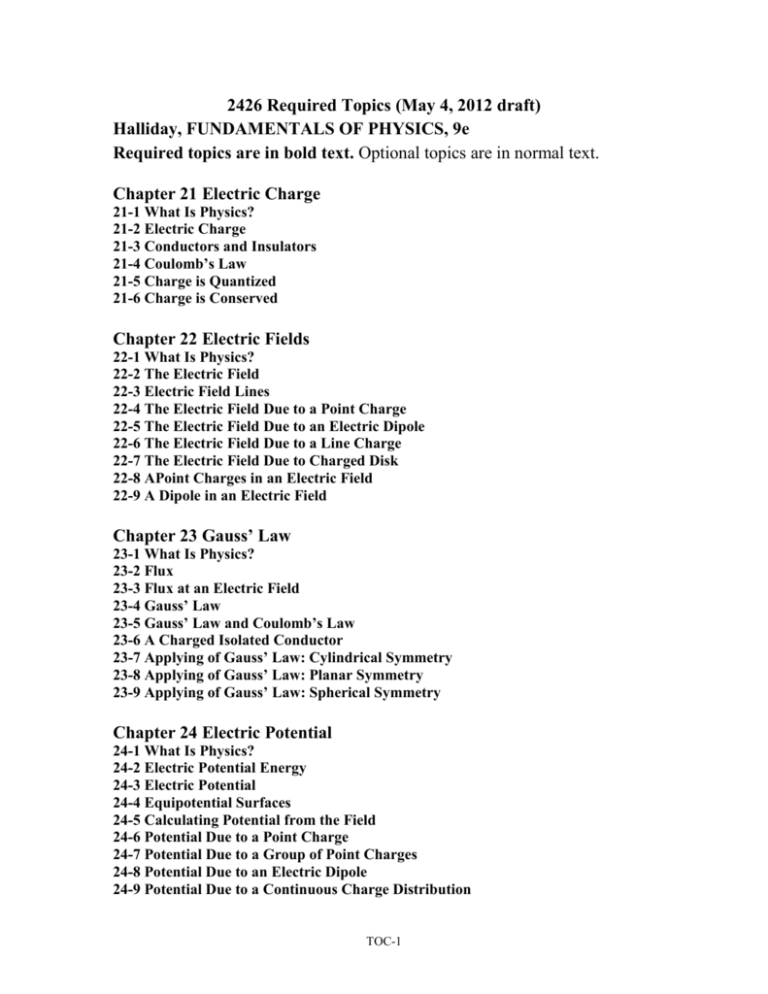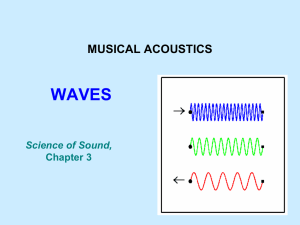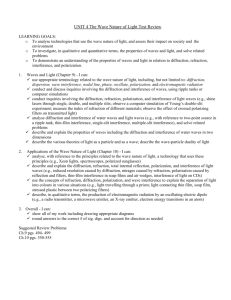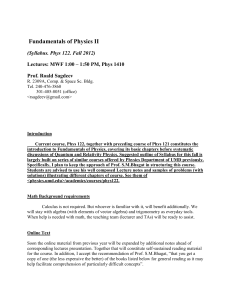Chapter 22 Electric Fields
advertisement

2426 Required Topics (May 4, 2012 draft) Halliday, FUNDAMENTALS OF PHYSICS, 9e Required topics are in bold text. Optional topics are in normal text. Chapter 21 Electric Charge 21-1 What Is Physics? 21-2 Electric Charge 21-3 Conductors and Insulators 21-4 Coulomb’s Law 21-5 Charge is Quantized 21-6 Charge is Conserved Chapter 22 Electric Fields 22-1 What Is Physics? 22-2 The Electric Field 22-3 Electric Field Lines 22-4 The Electric Field Due to a Point Charge 22-5 The Electric Field Due to an Electric Dipole 22-6 The Electric Field Due to a Line Charge 22-7 The Electric Field Due to Charged Disk 22-8 APoint Charges in an Electric Field 22-9 A Dipole in an Electric Field Chapter 23 Gauss’ Law 23-1 What Is Physics? 23-2 Flux 23-3 Flux at an Electric Field 23-4 Gauss’ Law 23-5 Gauss’ Law and Coulomb’s Law 23-6 A Charged Isolated Conductor 23-7 Applying of Gauss’ Law: Cylindrical Symmetry 23-8 Applying of Gauss’ Law: Planar Symmetry 23-9 Applying of Gauss’ Law: Spherical Symmetry Chapter 24 Electric Potential 24-1 What Is Physics? 24-2 Electric Potential Energy 24-3 Electric Potential 24-4 Equipotential Surfaces 24-5 Calculating Potential from the Field 24-6 Potential Due to a Point Charge 24-7 Potential Due to a Group of Point Charges 24-8 Potential Due to an Electric Dipole 24-9 Potential Due to a Continuous Charge Distribution TOC-1 24-10 Calculating the Field from the Potential 24-11 Potential of a Charged Isolated Conductor Chapter 25 Capacitance 25-1 What Is Physics? 25-2 Capacitance 25-3 Calculating the Capacitance 25-4 Capacitors in Parallel and in Series 25-5 Energy Stored in an Electric Field 25-6 Capacitor with a Dielectric 25-7 Dielectrics: An Atomic View 25-8 Dielectrics and Gauss’ Law Chapter 26 Current and Resistance 26-1 What Is Physics? 26-2 Electric Current 26-3 Current Density 26-4 Resistance and Resistivity 26-5 Ohm's Law 26-6 A Microscopic View of Ohm’s Law 26-7 Power in Electric Circuits 26-8 Semiconductors 26-9 Superconductors Chapter 27 Circuits 27-1 What Is Physics? 27-2 “Pumping” Charges 27-3 Work, Energy, and Emf 27-4 Calculating the Current in a Single-Loop Circuit 27-5 Other Single-Loop Circuits 27-6 Potential Difference Between Two Points 27-7 Multiloop Circuits 27-8 The Ammeter and the Voltmeter 27-9 RC Circuits Chapter 28 Magnetic Fields 28-1 What Is Physics? 28-2 What Produces a Magnetic Field 28-3 Definition of B 28-4 Crossed Fields: Discovery of the Electron 28-5 Crossed Fields: The Hall Effect TOC-2 28-6 A Circulating Charged Particle 28-7 Cyclotrons and Synchrotrons 28-8 Magnetic Force on a Current-Carrying Wire 28-9 Torque on a Current Loop 28-10 The Magnetic Dipole Moment Chapter 29 Magnetic Fields Due to Currents 29-1 What Is Physics? 29-2 Calculating the Magnetic Field Due to a Current 29-3 Force Between Two Parallel Currents 29-4 Ampere's Law 29-5 Solenoids and Toroids 29-6 A Current-Carrying Coil as a Magnetic Dipole Chapter 30 Induction and Inductance 30-1 What Is Physics? 30-2 Two Experiments 30-3 Faraday's Law of Induction 30-4 Lenz's Law 30-5 Induction and Energy Transfers 30-6 Induced Electric Fields 30-7 Inductors and Inductance 30-8 Self-Induction 30-9 RL Circuits 30-10 Energy Stored in a Magnetic Field 30-11 Energy Density of a Magnetic Field 30-12 Mutual Induction Chapter 31 Electromagnetic Oscillations and Alternating Current 31-1 What Is Physics? 31-2 LC Oscillations, Qualitatively 31-3 The Electrical-Mechanical Analogy 31-4 LC Oscillations, Quantitatively 31-5 Damped Oscillations in an RLC Circuit 31-6 Alternating Current 31-7 Forced Oscillations 31-8 Three Simple Circuits 31-9 The Series RLC Circuit 31-10 Power in Alternating-Current Circuits 31-11Transformers TOC-3 Chapter 32 Maxwell’s Equations, Magnetism of Matter 32-1 What Is Physics? 32-2 Gauss' Law for Magnetic Fields 32-3 Induced Magnetic Fields 32-4 Displacement Current 32-5 Maxwell’s Equations 32-6 Magnets 32-7 Magnetism and Electrons 32-8 Magnetic Materials 32-9 Diamagnetism 32-10 Paramagnetism 32-11 Ferromagnetism Chapter 16 Waves - I 16-1 What Is Physics? 16-2 Types of Waves 16-3 Transverse and Longitudinal Waves 16-4 Wavelength and Frequency 16-5 The Speed of a Traveling Wave 16-6 Wave Speed on a Stretched String 16-7 Energy and Power of a Traveling Wave Along a String 16-8 The Wave Equation 16-9 The Principle of Superposition for Waves 16-10 Interference of Waves 16-11 Phasors 16-12 Standing Waves 16-13 Standing Waves and Resonance Chapter 17 Waves – II 17-1 What Is Physics? 17-2 Sound Waves 17-3 The Speed of Sound 17-4 Traveling Sound Waves 17-5 Interference 17-6 Intensity and Sound Level 17-7 Sources of Musical Sound 17-8 Beats 17-9 The Doppler Effect 17-10 Supersonic Speeds, Shock Waves Chapter 33 Electromagnetic Waves 33-1 What Is Physics? 33-2 Maxwell’s Rainbow 33-3 The Traveling Electromagnetic Wave, Qualitatively 33-4 The Traveling Electromagnetic Wave, Quantitatively 33-5 Energy Transport and the Poynting Vector TOC-4 33-6 Radiation Pressure 33-7 Polarization 33-8 Reflection and Refraction 33-9 Total Internal Reflection 33-10 Polarization by Reflection Chapter 34 Images 34-1 What Is Physics? 34-2 Two Types of Image 34-3 Plane Mirrors 34-4 Spherical Mirrors 34-5 Images from Spherical Mirrors 34-9 Spherical Refracting Surfaces 34-10 Thin Lenses 34-11 Optical Instruments 34-12 Three Proofs Chapter 35 Interference 35-1 What Is Physics? 35-2 Light as a Wave 35-3 Diffraction 35-4 Young’s Interference Experiment 35-5 Coherence 35-6 Intensity in Double-Slit Interference 35-7 Interference from Thin Films 35-8 Michelson’s Interferometer Chapter 36 Diffraction 36-1 What Is Physics? 36-2 Diffraction and the Wave Theory of Light 36-3 Diffraction by a Single Slit: Locating the Minima 36-4 Intensity in Single-Slit Diffraction, Qualitatively 36-5 Intensity in Single-Slit Diffraction, Quantitatively 36-6 Diffraction by a Circular Aperture 36-7 Diffraction by a Double Slit 36-8 Diffraction Gratings 36-9 Gratings: Dispersion and Resolving Power 36-10 X-Ray Diffraction TOC-5








